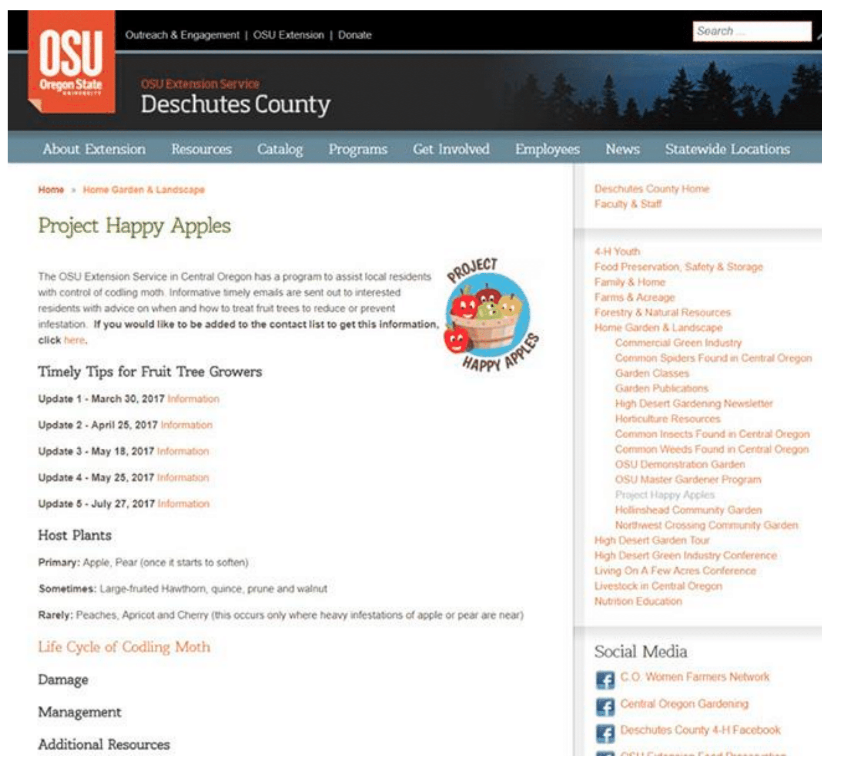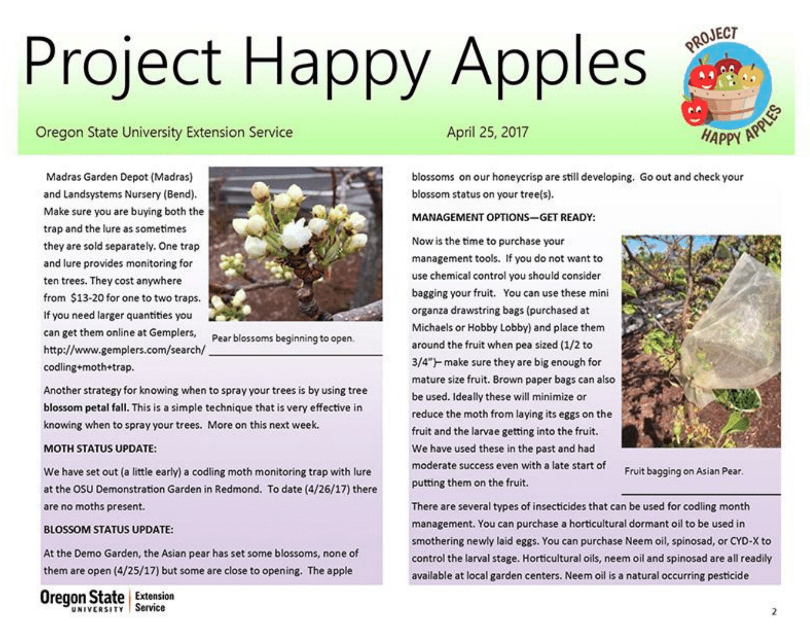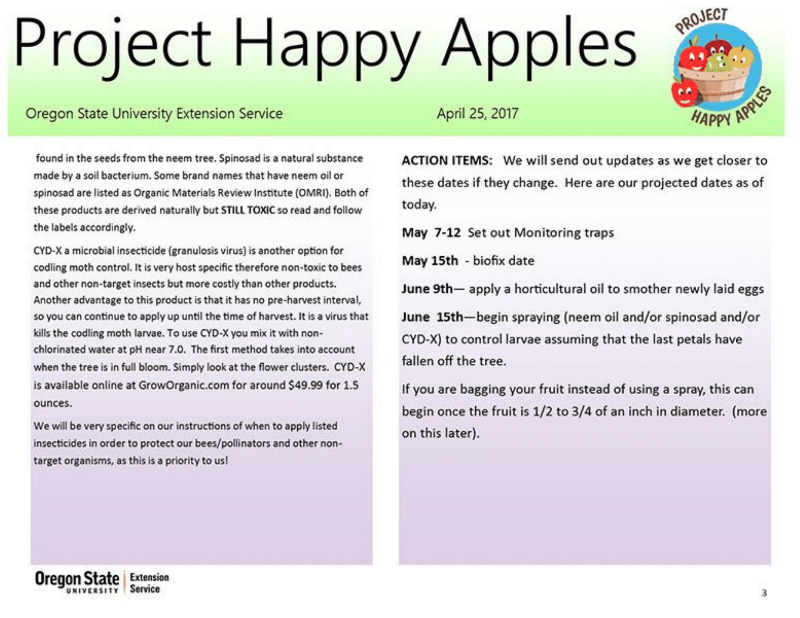 |
February 2019
|
February 2019 // Volume 57 // Number 1 // Ideas at Work // v57-1iw6
Project Happy Apples: Assisting Backyard Growers in Codling Moth Management
Abstract
Project Happy Apples began as an effort to assist backyard growers in managing codling moth in their fruit trees. We developed a process using emails and a web page to provide timely information related to the life cycle of codling moth and relevant integrated pest management (IPM) strategies. The content of our updates included pertinent photos, costs of tools, and suggested dates of action. Results from a survey of participants suggest that they were more confident, knowledgeable, and successful in using IPM strategies in their own backyards as a result of our project.
Introduction
As backyard food production continues to be a growing trend with backyard growers, so does their interest in growing fruit trees. One of the more devastating pests in apple and pear trees in Oregon and on an international level is codling moth (Cydia pomonella L.) (Witzgall, Stelinski, Gut, & Thomson, 2008). Those in university extension have assisted fruit tree growers with pest management using different forms of technology and communication methods; however, the emphasis primarily has been on assisting growers in commercial orchards (DiPietro & Miller, 2009; Pfeiffer & Love, 2007). In our experience of fielding hundreds of clients' questions related to codling moth management, we have found that most backyard growers have difficulty wading through the pest management–related technical specifications and degree-day model information intended for use by commercial growers. Backyard growers may be able to grasp the idea that successful management is directly related to temperature and the life cycle of codling moth but may lack confidence regarding knowing when and how to manage for this pest. In an effort to assist backyard growers in managing codling moth on a regional level, we initiated Project Happy Apples. The goal of our project is threefold: to help project participants increase their knowledge of when to monitor and manage for codling moth, to increase participants' confidence in purchasing tools and implementing integrated pest management (IPM) strategies, and to help participants reduce codling moth populations in their fruit.
Methods
We began Project Happy Apples in 2015 by collecting names of backyard growers interested in receiving timely email notifications. Every time someone contacts us to inquire about codling moth management we offer to add the individual's name to our distribution list. We also set up a web page dedicated to Project Happy Apples (Figure 1) for those who prefer direct access instead of emails, and we provide an email opt-in on the web page. During the first two and a half years or so of the project (April 2015 through November 2017), 479 participants signed up for inclusion on the distribution list. We promote the project using social media and local media, including newspapers. We created the project name as well as an accompanying logo to help promote the project.
Figure 1.
Screen Shot of Project Happy Apples Web Page

Using fruit trees in our Extension demonstration garden, we set up monitoring devices to track the flight of the codling moth. We recorded moth catch data frequently as those data were used in determining when to apply sprays. In the email communications and on the web page, we encourage backyard growers to set up their own monitoring devices. Additionally, timely updates are created and sent out to the email distribution list as pdf files and uploaded on the web page. An average of four to five updates are sent each season. The updates are specific and simple. Information may include the following content:
- photos of monitoring devices or tools, an adult or larval codling moth, blossom stage or damage to the fruit (Figure 2);
- a list of tools and supplies to buy for monitoring and management, along with their associated costs, and a list of local or online retailers;
- specific dates for when to take action for monitoring and management based on blossom petal fall and degree-day calculations for the region (Figure 3);
- pros and cons of different types of IPM; and
- a list of additional resources.
Figure 2.
Example Excerpt from an Update Sent to Project Participants

Figure 3.
Example of Action Items Included in an Update Sent to Project Participants

Results
An 11-question postseason survey was sent in November, 2016, and was completed by 32 participants. Questions related to ease of use, knowledge gain, pesticide use, costs, time spent managing, and overall experience as a project participant. Survey results suggested that project goals were being met (Detweiler & Stephan, 2017). The plurality of respondents, 25%, learned about the project through the newspaper. Ninety-one percent of respondents found the content of the emails to be useful in making pest management decisions for codling moth. Eighty-one percent of respondents agreed or strongly agreed that because of reading the monthly emails they found themselves having an increased level of confidence in making pest management decisions. Sixty-nine percent of respondents agreed or strongly agreed that they were successful in reducing the codling moth population in their yards as compared to what would have been the case had they taken no action. Sixty-six percent of respondents agreed or strongly agreed that their pest management practices were more effective than they had been prior to participating in the project. Ninety-seven percent of respondents felt slightly higher to much higher levels of knowledge about when to put up physical barriers for the management of codling moth. Ninety-one percent of respondents felt slightly higher to much higher levels of knowledge about when to apply an insecticide for codling moth.
Implications
Results suggest that our project has been successful in increasing participants' knowledge about when to use IPM strategies and confidence in making pest management decisions. The dates for managing codling moth vary from year to year as their life cycle is dependent on weather. Our project helps take the guesswork out of knowing when to manage for codling moth. One lesson learned during the first year of our project was that writing updates took longer than expected, putting us behind schedule in sending timely emails. Therefore, we determined that it is best to have all update information ready to go at the start of the season so that it can be released when needed. We also recommend creating a list of photos to be taken throughout the year for inclusion in updates. In the second and third years of our project, we were better prepared and timelier in sending out updates. Ideally, now that project participants are armed with knowledge on timing and tools, they will integrate successful IPM programs, reduce pesticide use, and reduce codling moth damage in their home orchards. Our directive approach can be adopted and used for assisting backyard growers in other areas and with other common garden pests.
Acknowledgment
We thank Len Coop, Oregon State University entomologist, for assisting us with life cycle information for codling moth.
References
Detweiler, A. J., & Stephan, T. (2017). Project happy apples: Educating homeowners in codling moth management for backyard orchards. HortScience Supplement, 52(9), S135–136.
DiPietro, L., & Miller, M. (2009). Extending expertise through conference calls and blogging. Journal of Extension, 47(6), Article 6TOT6. Available at: https://joe.org/joe/2009december/tt6.php
Pfeiffer, D. G., & Love, K. (2007). Handheld applications in fruit extension delivery. Journal of Extension, 45(5), Article 5TOT6. Available at: https://www.joe.org/joe/2007october/tt6.php
Witzgall, P., Stelinski, L., Gut, L., & Thomson, D. (2008). Codling moth management and chemical ecology. Annual Review of Entomology, 53(1), 503–522.




